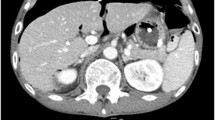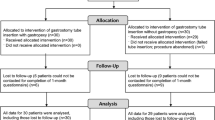Purpose: T-fastener gastropexy is used by many interventional radiologists during percutaneous radiologic gastrostomy (PRG) placement. Whether gastropexy is a prerequisite to safe gastrostomy placement is uncertain. We evaluated the use of T-fastener gastropexy versus no gastropexy for PRG in a prospective, randomized study. Methods: Of 90 consecutive patients referred for PRG, 48 were randomly selected to receive T-fastener gastropexy (M:F, 35:13; mean age 62 years, range 20–90 years) and 42 to receive no gastropexy (M:F, 31:11; mean age 63 years, range 40–90 years). Technical difficulties and fluoroscopy times were recorded for both groups and all patients were followed up for postprocedural complications. T-fasteners were removed between 3 and 7 days after gastrostomy insertion. Results: A major complication was encountered in four patients from the non-gastropexy group (10%). In these cases the guidewire and dilator "flipped" out of the stomach into the peritoneal cavity. This resulted in misplacement of the gastrostomy tube in the peritoneal cavity in two of the patients. This was discovered at the end of the procedure when a test injection of contrast medium was performed. In three of these patients the procedure was rescued and completed radiologically. One patient underwent endoscopic gastrostomy placement. Five of 48 patients (10%) who received a gastropexy had pain associated with the T-fastener sites. Six patients (13%) had skin excoriation at the T-fastener sites. No skin complications were seen in the non-gastropexy group. No statistical difference in fluoroscopy time was observed between the two groups. Conclusion: Our experience of PRG without T-fastener gastropexy involved a 10% incidence of serious technical complications. We suggest that T-fastener gastropexy should be performed routinely for all PRG procedures. T-fastener gastropexy has an associated minor complication of pain and skin excoriation at the gastrostomy site which resolves on removing the T-fasteners.
Similar content being viewed by others
Author information
Authors and Affiliations
Rights and permissions
About this article
Cite this article
Thornton, F., Fotheringham, T., Haslam, P. et al. Percutaneous Radiologic Gastrostomy With and Without T-Fastener Gastropexy: A Randomized Comparison Study. CVIR 25, 467–471 (2002). https://doi.org/10.1007/s00270-001-0089-4
Issue Date:
DOI: https://doi.org/10.1007/s00270-001-0089-4




